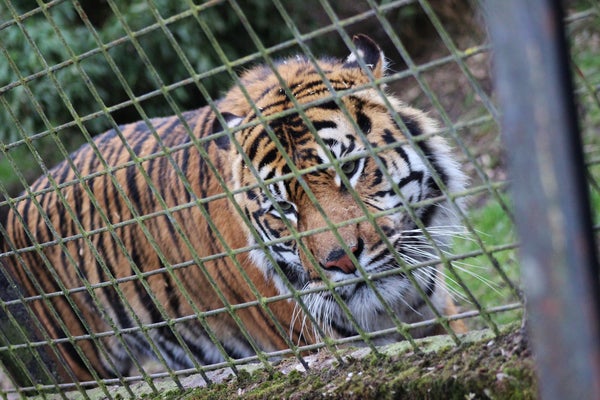This article was published in Scientific American’s former blog network and reflects the views of the author, not necessarily those of Scientific American
The illegal trade in tiger claws, teeth, skins and other body parts continues to surge, driven mostly by the ready supply of big cats at Asia’s 200 tiger farms, a worrying new report finds.
The report, published this week by TRAFFIC, the wildlife trade monitoring network, found that at least 30 percent of the tiger-related customs seizures between 2012 and 2015 were reported to have come from captive breeding facilities. That’s up from just 2 percent between 2000 and 2003.
The numbers beyond that are equally staggering. Only about 3,800 tigers remain in the wild, but body parts or live animals totaling an estimated 1,755 tigers have been seized since the year 2000, according to the report. As with any crime, the seizures probably represent just a tiny fraction, perhaps just 5 percent, of the total level of activity. The sheer volume of tiger trafficking suggests that many of the seized animals come not from the wild but from legal and illegal breeding facilities, which the Environmental Investigation Agency estimates hold between 7,000 and 8,000 tigers in Asia.
On supporting science journalism
If you're enjoying this article, consider supporting our award-winning journalism by subscribing. By purchasing a subscription you are helping to ensure the future of impactful stories about the discoveries and ideas shaping our world today.
Asia is not alone. Here in the United States, several thousand tigers live in backyard zoos and peoples’ homes. Many conservationists fear that these untracked animals also end up feeding into the illegal trade for tiger parts.
The nature of this trade has changed over the years. Although tiger skins were the most traded body part during the entire 2000-2015 period, that appears to have slowed down in the more recent years, to be replaced by tiger bones, which (like many other tiger body parts) are used in traditional medicines.
The trade in live tigers has also skyrocketed from just 17 animals seized between 2000 and 2003 to 179 between 2012 and 2015, another indication that the animals come from captive-breeding facilities. (Indeed, quite a few of these seizures were at breeding locations or tourist sites.)
Interestingly, the report pretty much puts to bed the myth that people are killing tigers for their penises, to be used as an aphrodisiac. According to TRAFFIC, no tiger genitalia have been found on the market in more than a decade.
None of this means that tigers in the wild are any safer just because so many cats exist in captivity. As I have written before, traditional Asian medicine and culture values wild products more than farm-raised. The steady market of captive-bred tiger products, therefore, actually stimulates consumer demand and puts more pressure on wild tigers. India alone has already lost at least 76 tigers to poachers so far this year, the highest number since 2010—and that just counts the deaths that have been reported.
TRAFFIC is calling for all existing tiger farms to immediately begin recording and managing their captive cats in a central database, complete with DNA profiles and photographs (each tiger’s stripes form unique markers). This, they argue, will help prevent any captive tigers from “leaking” into the illegal trade. The end-goal, they write, should be the complete ban on tiger farming throughout Asia, something that has already started in Laos and Thailand.
WWF, which manages TRAFFIC with the IUCN, is also calling for all of the world’s governments to “support an Indian government proposal to create a regional stripe pattern database that can compare images of seized tiger skins with camera trap photos of wild tigers and photos of captive tigers; compile sets of DNA markers from both wild and captive tiger populations within their country; and launch focused, evidence-based behavioral change programs to reduce demand for tiger parts and products.”
It’s this last part that remains the key. As long as people keep paying small fortunes for live tigers and the products made from their bodies, then the killing will continue.
Previously in Extinction Countdown:
